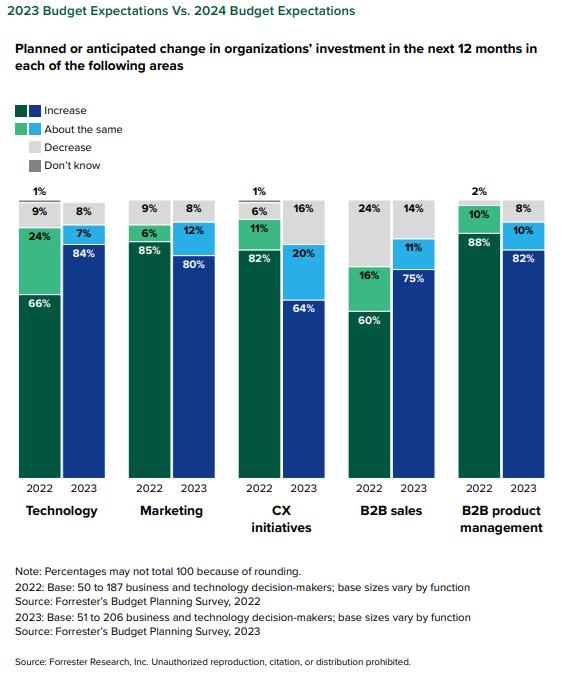In the past few years, technology leaders navigated a complex maze of challenges—ranging from global unrest and supply chain hiccups to skyrocketing inflation. However, the future looks bright. Supply chain bottlenecks are loosening, inflation is trending back toward target levels, and the IMF forecasts a more stable economic trajectory ahead.
According to Forrester’s 2023 Budget Planning Survey, an expected shift is underway: 84% of technology leaders anticipate an uptick in their 2024 tech budgets, a substantial increase from last year’s 66%. This sets the stage for a fundamentally different budgeting approach this year.
So, where should this additional funding be allocated? Let’s delve into specific recommendations from the report.
Prioritize Investments in Data, Security, and AI
With tech evolving at a breakneck pace, staying ahead of the curve is crucial. According to the survey, a significant majority of tech leaders are expecting an increase in their technology budgets for 2024. The spotlight is on data analytics, cybersecurity, and Artificial Intelligence (AI).
Given the increasing threats to data security and the potential of AI in transforming business operations, these areas warrant special attention. Consider setting aside a dedicated budget for upskilling your team in these domains and for implementing advanced tools that can give you a competitive edge.
Reevaluate Customer Experience (CX) Investments
Customer Experience (CX) has been a buzzword for several years now. However, the focus seems to be shifting. If CX initiatives are not yielding the expected ROI or if they are not aligned with your strategic goals for 2024, it may be time to reconsider.
This doesn’t mean slashing the CX budget indiscriminately but reallocating those funds to initiatives that promise higher returns—be it data analytics, AI, or cybersecurity.

Invest in Robust Data Governance and Security Tools
Data is often termed the ‘new oil,’ but it’s also a double-edged sword. While it can provide invaluable insights, poor data governance can lead to security vulnerabilities.
Investing in robust data governance frameworks is no longer optional. Similarly, with the increasing sophistication of cyber threats, traditional firewalls and antivirus software are no longer sufficient. Consider investing in advanced security analytics tools that employ machine learning algorithms to identify and neutralize threats in real-time.
Conduct a Tech Audit for Operational Efficiency
Operational efficiency is not just a catchphrase; it’s a necessity. A tech audit can be an eye-opener in this regard. It can help you identify redundant tools and overlapping software licenses that are draining your resources.
By streamlining these aspects, you can free up funds for more strategic initiatives like digital transformation or AI integration.
Allocate Funds for AI and Automation Experiments
AI and automation are no longer futuristic concepts; they are current realities. From chatbots that handle customer queries to AI algorithms that analyze market trends, the applications are endless.
Consider allocating a portion of your budget for pilot projects in these areas. Start small, measure the effectiveness, and then scale up. The key is to be agile and adaptive.
Plan for Cloud Scalability
The cloud has revolutionized the way businesses operate, offering unprecedented scalability and flexibility. However, it comes with its own set of challenges, such as data migration and security. As you budget for cloud services, factor in these aspects.
Consider hybrid cloud models that offer the best of both worlds—public and private clouds. Also, budget for training your team in cloud management and cybersecurity best practices.
The Wrap
2024 is shaping up to be a pivotal one for technology leaders. With tech budgets on the rise, there’s a unique opportunity to make impactful investments in key areas such as Data Analytics, Cybersecurity, and Artificial Intelligence. Operational efficiency remains a priority, necessitating regular tech audits and resource optimization.
As businesses continue to embrace the cloud, planning for scalability and security is more important than ever. The overarching strategy for success in this new age involves thoughtful planning, agile execution, and a commitment to continuous adaptation.






